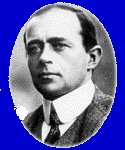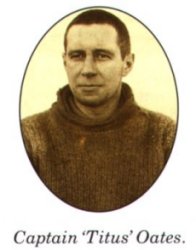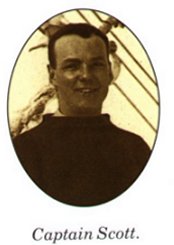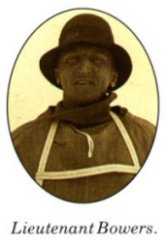
1868–1912
British naval officer and Antarctic explorer.


1868–1912
British naval officer and Antarctic explorer.

Captain Robert Falcon Scott was a British Naval Officer before he went exploring the Antarctic. He was just 13 when he joined the training ship Britannia in 1881.
He led two explorations to Antarctic. The first expedition occurred in 1901-1904 and had been planned for several years. His ship the "Discovery" was specially made for this expedition. The team's purpose of this trip was to carry out scientific experiments and collect as much data of the land, particularly the region around the Ross Sea. While on this expedition, Scott made some discoveries. He learnt more about the sounding of the sea. He discovered King Edward VII Land. (which is now known as Edward VII Peninsula) He surveyed the coast of Victoria Land, and made an important exploring trip with Edward Wilson and Ernest Shackleton on the Antarctic continent itself, where they reached a new “farthest south” of 82°17'. Scott decided to use sleds drawn by dogs for his exploration but they died on the return home leaving the three men to pull the sleds themselves. On his return voyage home Scott was promoted Captain.
He took a few months leave after his journey to the Antarctic and wrote a book which was completed in 1905 and called 'The Voyage of the Discovery"
The second expedition was planned by Scott when former teammate Ernest Shackleton failed to reach the South Pole and scientists began to criticize Scott's experiments because they were not accurate enough. He was thirty-three when he set out to the South Pole for the second time on 1 June 1910 aboard the "Terra Nova". His company consisted of Edward Wilson a member of the first expedition undertaken by Scott. Wilson's position on the exploration was chief scientist and he was put in charge of selecting a group of scientists to work with him. Scott chose the rest of the team very carefully. They included Lieutenant Henry Bowers, a serving marine, Apsley Cherry-Garrad who helped fund the expedition and who was not one of the five travelers who perished. There was also Herbert Pointing, a well known photographer, Petty officer E Evans, and Captain Lawrence Oates who had great experience with animals.





When Scott and his companions set out they decided to use two motorized sleds to carry the supplies as far as possible. The plan was that the sleds would for certain, break down, and when they did the dogs and Siberian ponies would take the stores and drop them off along the route before returning home. On the journey to the South Pole twelve men set out. When the party had finally reached the summit of the Beardmore Glacier there were eight men left (the others had been sent back with the empty sleds). Scott had to make a decision on who would continue on and who would return to the base. The ponies had done better than Scott had expected and four had made it up to the summit along with the men, but the group needed the food and so they were killed. It was decided finally that Lieutenant Evans, Lashly and Crean were to return to the base in the second sled while Scott, Wilson, Oates, Bowers, and Officer Evans were to continue on. While Scott and his companions continued toward their goal, the returning three suffered great difficulties. Lieutenant Evans became ill and collapsed. He begged the other two to leave him, but they refused. Lashly and Crean pulled Evans onto the sled and pulled it onwards themselves because their dogs had died. Finally they could pull the sled no longer and so the group split up with Lashly remaining with Evans while Crean continued on. Crean made it barely back to the base after eighteen hours and a search party set out and collected Lashly and Evans.
Twelve days after the two groups split up Scott and his teammates were just 40 kilometres from their destination. They had seen no sign of Amundsen who was also racing to the South Pole, and so their hopes lifted. On January 18 Scott, Bowers, Oates, Evans, and Wilson reached the South Pole and discovered Amundsen's abandoned tent and a note that he left behind. The note read
Scott and his companions were devastated, they now had to travel 1300 kilometres back to their camp. After a night's rest they began their homeward journey. All was well for the first five days of the journey home. Scott erected a sail that enabled the sled to travel at great speed, allowing the men to travel beside it rather than pull it themselves and thus more distance was covered by the men. Then the wind changed and the sled had to be hauled by the five men. Scott had developed special harnesses after his previous experience, and this was how the men pulled the sled. Suddenly a blizzard struck and the party was forced to make camp until it blew over. It was from here on that their real troubles began. When the party was able to start again, they found the travelling more difficult, and the weather even more cold. They were also beginning to grow tired.
Their main problem was their diet. Scientists of this time had not understood the requirements that the body needed, and so the group was lacking in vitamins and minerals, which caused them to slow down and grow wearier. Despite this, they continued on. Suddenly, as they were walking, Scott and Evans disappeared from sight. They had fallen into a hidden crevasse. Scott was unhurt, but Evans was badly dazed, but after a while all seemed well. On 7 February they reached one of their food deposits on Beardmore Glacier. The men were still thinking of their scientific experiments and collected rock samples of the area before continuing the march down. It was on their way down that Evans began to stumble. He had not recovered from his fall and never did. The party camped at the bottom of the glacier and tried to help Evans, who was also becoming very ill. It was a hopeless task, and Evans died at midnight that night.
There was now only a group of four. Scott, Oates, Wilson, and Bowers. They buried Evans and began to cross the Ice Shelf. The men did not go hungry due to the stores they had left along the trail, but the route was now difficult to travel on because of deep snow a recent blizzard had left. This made the men tired and weak, and frostbite began to affect them all. Oates had the worst symptoms of them all. His feet were a mass of frostbite and gangrene had also appeared. He could no longer pull the sled and walked in constant pain. It soon became clear that Oates was dying, but even though he slowing them up, the group refused to leave him and let him die. On 17 March another blizzard set in and so the group made camp. Oates did the bravest thing a person could ever do. He realized he could be the cause of his teammate's deaths and so after saying he was going outside, he disappeared into the snow and walked to his death.
For eight more days the group continued on, now down to three. Their destination was to reach the safety of a food store, known as One Ton Depot. A blizzard raged on the whole time, and on 29 March Scott wrote in his dairy admitting that they were doomed. He wrote one of his most well known pieces. "We shall stick it out to the end, but we are getting weaker, of course, and the end cannot be far. It seems a pity, but I cannot write anymore For God's sakes look after our people."
Over eight months later, Atkinson, the leader of a search party, found the three men. Wilson and Bowers had died peacefully in their sleep but Scott had had a painful final few minutes. He was found with his hand stretched towards Wilson. It was believed that scurvy killed these men. Scurvy is a disease caught due to the lack of vitamin C, it causes the gums to swell and bleed and produces extreme physical weakness or exhaustion. Scott and his companions collected some vital information to the understanding of Antarctic before they died. The rock samples that the men collected on Beardmore Glacier and taken by Atkinson back to London, dated back to 200 million years ago and contained fossils that proved Antarctic was once a lush tropical country.
